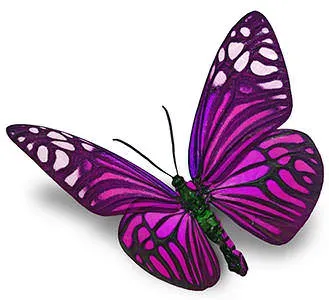 Butterflies are beautiful flying insects with four large patterned, brightly colored, scaly wings. Tiny sensory hairs cover the body of a butterfly. These hairs are pigmented with melanin that gives them black and brown colors. Uric acid derivatives give the wings their yellow colors, while blues, reds, greens and iridescent colors are caused by the structure of their scales and hairs. Like all insects, butterflies have six jointed legs, three body parts- the head, thorax (the chest), and abdomen (the tail end), a pair of antennae, compound eyes, and an exoskeleton.
Butterflies are beautiful flying insects with four large patterned, brightly colored, scaly wings. Tiny sensory hairs cover the body of a butterfly. These hairs are pigmented with melanin that gives them black and brown colors. Uric acid derivatives give the wings their yellow colors, while blues, reds, greens and iridescent colors are caused by the structure of their scales and hairs. Like all insects, butterflies have six jointed legs, three body parts- the head, thorax (the chest), and abdomen (the tail end), a pair of antennae, compound eyes, and an exoskeleton.
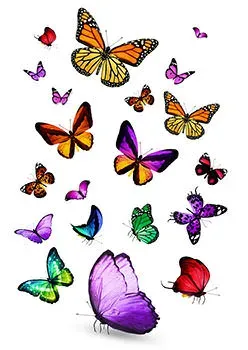 Butterflies are part of the class of insects called Lepidoptera, along with moths. "Lepidos"" is Greek for ""scales"" and ""ptera"" means ""wing"". The Lepidoptera group is enormous- there are more types of butterflies and moths than there are of any other type of insect, except for beetles. There are around 150,000 different species of butterflies and moths- 28,000 of these are butterfly species, and the rest are moths."
Butterflies are part of the class of insects called Lepidoptera, along with moths. "Lepidos"" is Greek for ""scales"" and ""ptera"" means ""wing"". The Lepidoptera group is enormous- there are more types of butterflies and moths than there are of any other type of insect, except for beetles. There are around 150,000 different species of butterflies and moths- 28,000 of these are butterfly species, and the rest are moths."
 Butterfly fossils date all the way back to the Paleocene epoch, a geologic time about 56 million years ago, while the earliest Lepidoptera fossils are of a small moth from the Jurassic age, around 190 years ago. Butterflies can only fly if their body temperature is above 86 degrees so they absorb sunlight to warm up in cold weather. They can fly between 5-30 miles per hour. As butterflies age, the color of their wings fades, and their wings become ragged.
Butterfly fossils date all the way back to the Paleocene epoch, a geologic time about 56 million years ago, while the earliest Lepidoptera fossils are of a small moth from the Jurassic age, around 190 years ago. Butterflies can only fly if their body temperature is above 86 degrees so they absorb sunlight to warm up in cold weather. They can fly between 5-30 miles per hour. As butterflies age, the color of their wings fades, and their wings become ragged.
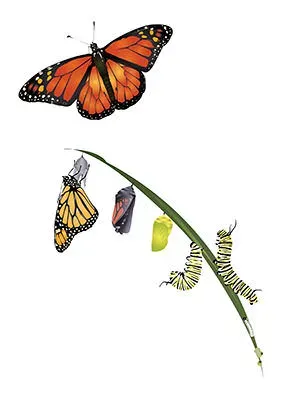 What is fascinating about butterflies is that they go through complete metamorphoses during their lives, which happen in four different stages. A butterfly starts off as an egg, often laid on a leaf. These eggs can hatch within a few days, or within months or even years. The larva, or caterpillar, then hatches from the egg and eats flowers or leaves. The caterpillar then loses its skin many times while it grows and will increase significantly in size before it reveals a skin that will harden to form the chrysalis or pupa. This is a resting stage of its life. The word �pupa� comes from the metallic gold-coloration found in the pupa of many butterflies, referred to by the Greek term �chrys�s,� meaning gold. Then, during the last stage of their lives, the metamorphosis is finally complete- the pupal skin splits, and a beautiful butterfly climbs out. After its wings expand and dry, the butterfly begins to fly.
What is fascinating about butterflies is that they go through complete metamorphoses during their lives, which happen in four different stages. A butterfly starts off as an egg, often laid on a leaf. These eggs can hatch within a few days, or within months or even years. The larva, or caterpillar, then hatches from the egg and eats flowers or leaves. The caterpillar then loses its skin many times while it grows and will increase significantly in size before it reveals a skin that will harden to form the chrysalis or pupa. This is a resting stage of its life. The word �pupa� comes from the metallic gold-coloration found in the pupa of many butterflies, referred to by the Greek term �chrys�s,� meaning gold. Then, during the last stage of their lives, the metamorphosis is finally complete- the pupal skin splits, and a beautiful butterfly climbs out. After its wings expand and dry, the butterfly begins to fly.
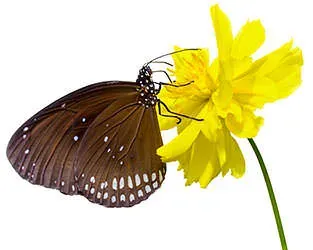 Butterflies and moths can only sip on liquid food, such as nectar from flowers and liquid from rotting fruits. They do so using an elongated sucking mouth part called a proboscis, which is tubular and flexible. The proboscis uncoils to sip food, and coils up again into a spiral when finished sipping.
Butterflies and moths can only sip on liquid food, such as nectar from flowers and liquid from rotting fruits. They do so using an elongated sucking mouth part called a proboscis, which is tubular and flexible. The proboscis uncoils to sip food, and coils up again into a spiral when finished sipping.
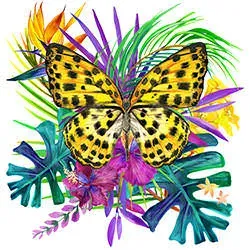 Most butterflies are found in tropical areas, but they exist all over the world in all types of environments. They live in hot and cold climates, dry and moist climates, and at sea level as well as high up in the mountains. Antarctica is the only continent where butterflies do not live, as butterflies avoid harsh, cold weather and tend to migrate when these conditions exist.
Most butterflies are found in tropical areas, but they exist all over the world in all types of environments. They live in hot and cold climates, dry and moist climates, and at sea level as well as high up in the mountains. Antarctica is the only continent where butterflies do not live, as butterflies avoid harsh, cold weather and tend to migrate when these conditions exist.
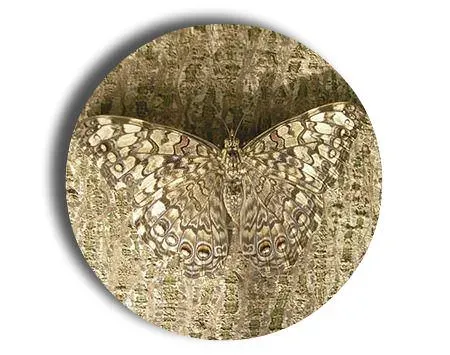 There are many threats to the lives of butterflies by other natural species and as such, they have ways of defending themselves from these predators. One method is by disguising themselves- a method called "cryptic coloration,""- where the butterfly hides by looking like a leaf or blending into the bark of a tree. Chemical defense is another method, where the butterflies that have toxic chemicals in their bodies use this to defend themselves. The butterflies that have these toxic chemicals are usually very brightly colored."
There are many threats to the lives of butterflies by other natural species and as such, they have ways of defending themselves from these predators. One method is by disguising themselves- a method called "cryptic coloration,""- where the butterfly hides by looking like a leaf or blending into the bark of a tree. Chemical defense is another method, where the butterflies that have toxic chemicals in their bodies use this to defend themselves. The butterflies that have these toxic chemicals are usually very brightly colored."
Besides threats to their lives by other species, butterflies also have to adapt to climate change, and habitat change caused by commercial, residential and agricultural development.
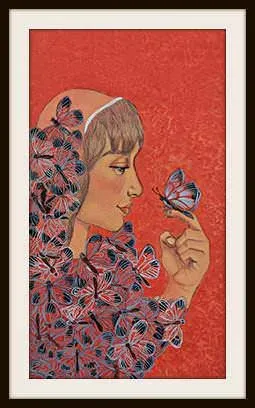 Culturally, butterflies are a popular motif in the visual and literary arts. The symbolic lesson of the life of the butterfly is that we should be able to accept changes in our lives as casually as the butterfly does. The butterfly adapts gracefully, and embraces the changes of her environment and her body. Symbolic butterfly meanings are vulnerability, growth, elegance, celebration, lightness, surrender, expression, resurrection, transition, expansion, grace, time, and in many different cultures- the soul.
Culturally, butterflies are a popular motif in the visual and literary arts. The symbolic lesson of the life of the butterfly is that we should be able to accept changes in our lives as casually as the butterfly does. The butterfly adapts gracefully, and embraces the changes of her environment and her body. Symbolic butterfly meanings are vulnerability, growth, elegance, celebration, lightness, surrender, expression, resurrection, transition, expansion, grace, time, and in many different cultures- the soul.